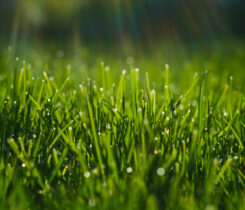Off the Record: Is Poa annua a friend or foe?
A few weeks ago, the ‘Idea of the Day’ on LinkedIn was titled: Rethinking weeds. The quote with a close-up picture of a dandelion said, “We need weeds. They help to keep part of our spirit wild. And when we look upon them in a new light — they can be quite beautiful.”
I thought about my perceptions of annual bluegrass or Poa annua — particularly the love-hate relationship with this grass. As a kid working on a golf course in El Cajon, Calif., I remember how it was a constant battle to keep Poa annua out of bentgrass greens. Yet, there were courses with greater than 90 percent Poa annua putting greens along the California coast.
Not Without Merit
Charles Piper, Ph.D., and Russell Oakley, Ph.D., penned an article in the March 1921 United States Golf Association Bulletin of the Green Section. The following is an excerpt from the article.
“As a putting grass, Poa annua is not without merit, at least in some latitudes. When abundant enough to make a solid turf, its putting quality is most excellent but a little slow. If only scattered plants occur in the turf, it is sometimes objectionable, as it may make the putting surface uneven. No matter how closely the grass is cut, it will still blossom and make seeds at the very surface of the ground. As the grass nears maturity, it gradually becomes paler, partly due to the abundant flowers, and is then not so attractive.”
As the Oklahoma turfgrass extension specialist in the mid-1980s, I only considered Poa annua as a weed to eradicate from the golf course. In the summer of 1987, I presented a progress report on the Oklahoma State University bermudagrass breeding program to the USGA Turfgrass Research Committee meeting in Salt Lake City, Utah. Donald White, Ph.D., also attended and talked about his annual bluegrass breeding program at the University of Minnesota. I was stunned that the USGA was supporting the development of Poa annua for putting greens.
Change of Mind
Fast forward to 1990, and now I am working as the research director for the USGA Green Section. Three years after 1987, I had mellowed on the idea of annual bluegrass breeding and the release of a variety. After traveling extensively to the Northeast and Pacific Northwest, I saw perennial biotypes of annual bluegrass that provided excellent putting surfaces.
White released ‘DW-184’ or ‘True Putt’ creeping bluegrass to Peterson Seed in 1997. Genetic classification suggested the more perennial types of annual bluegrass were Poa annua var. reptans. He renamed it creeping bluegrass to remove the stigmas of planting your greens with a grassy weed.
One of the early problems with ‘DW-184’ is infestation with larger, unwanted Poa annua in newly established putting greens. White thought this contamination was a production problem keeping unwanted wild-type annual bluegrass out of the seed production fields. New greens seeded with ‘DW-184’ were very rough-looking, but lower cutting heights slowly eliminated the coarser, less attractive plants.
Breeding for the Future
In 1998, David Huff, Ph.D., started a breeding program at Pennsylvania State University to develop greens-type Poa annua with better temperature and disease tolerance. He collected more than 2,500 samples of greens-type Poa annua from the Northeast, Mid-Atlan- tic and Northwest U.S. Huff narrowed the vast collection to a few promising parents for a seed-propagated variety.
Unfortunately, the story ends here for now because Huff found that many greens-type Poa annua revert to ugly ducklings when put into seed production fields. It was not weed contamination but a genetic switch that caused taller, wider leafed, weedy plants that were undesirable for a putting green. Low mowing can cause plants to become smaller and denser, but they never return to the quality of their parents.
Don White passed away in Decem- ber 2016 at the age of 86. His and Dave Huff’s goal to provide improved annual bluegrasses for golf is on hold. Yet, the USGA at least supports extensive research on managing naturally occurring ring Poa annua disease and insect problems. Whether you think it is a weed or not, Poa annua is here to stay for some time into the future.












